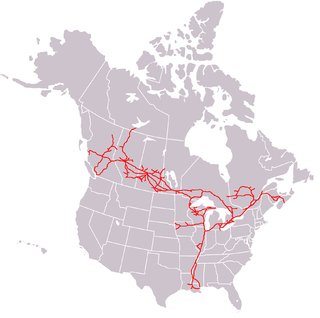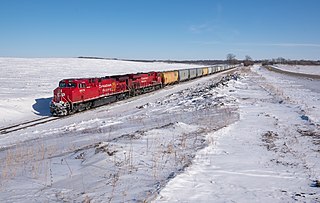
The Canadian Pacific Railway, also known simply as CPR or Canadian Pacific and formerly as CP Rail (1968–1996), was a Canadian Class I railway incorporated in 1881. The railway was owned by Canadian Pacific Kansas City Limited, known until 2023 as Canadian Pacific Railway Limited, which began operations as legal owner in a corporate restructuring in 2001.

The Canadian National Railway Company is a Canadian Class I freight railway headquartered in Montreal, Quebec, which serves Canada and the Midwestern and Southern United States.

The Soo Line Railroad is one of the primary United States railroad subsidiaries for the CPKC Railway, one of six U.S. Class I railroads, controlled through the Soo Line Corporation. Although it is named for the Minneapolis, St. Paul and Sault Ste. Marie Railroad (MStP&SSM), which was commonly known as the Soo Line after the phonetic spelling of Sault, it was formed in 1961 by the consolidation of that company with two other CPKC subsidiaries: The Duluth, South Shore and Atlantic Railway, and the Wisconsin Central Railway. It is also the successor to other Class I railroads, including the Minneapolis, Northfield and Southern Railway and the Chicago, Milwaukee, St. Paul and Pacific Railroad. On the other hand, a large amount of mileage was spun off in 1987 to Wisconsin Central Ltd., now part of the Canadian National Railway. The Soo Line Railroad and the Delaware and Hudson Railway, CPKC's other major subsidiary, presently do business as the Canadian Pacific Railway (CP). Most equipment has been repainted into the CP scheme, but the U.S. Surface Transportation Board groups all of the company's U.S. subsidiaries under the Soo Line name for reporting purposes. The Minneapolis headquarters are in the Canadian Pacific Plaza building, having moved from the nearby Soo Line Building.

The EMD FP7 is a 1,500 horsepower (1,100 kW), B-B dual-service passenger and freight-hauling diesel locomotive produced between June 1949 and December 1953 by General Motors' Electro-Motive Division and General Motors Diesel. Final assembly was at GM-EMD's La Grange, Illinois plant, excepting locomotives destined for Canada, in which case final assembly was at GMD's plant in London, Ontario. The FP7 was essentially EMD's F7A locomotive extended by four feet to give greater water capacity for the steam generator for heating passenger trains.

The Duluth, Winnipeg and Pacific Railway is a subsidiary railroad of Canadian National Railway (CN) operating in northern Minnesota, United States. A CN system-wide rebranding beginning in 1995 has seen the DWP logo and name largely replaced by its parent company. The DWP line is CN's connection between International Falls and Duluth, Minnesota, where the railroad connects to a short stretch of the former Duluth, Missabe and Iron Range Railway before following the former Wisconsin Central to Chicago, Illinois.

The Canadian is a transcontinental passenger train operated by Via Rail with service between Union Station in Toronto, Ontario, and Pacific Central Station in Vancouver, British Columbia, Canada.

The Super Continental was a transcontinental Canadian passenger train operated by the Canadian National Railway from 1955 until 1977, when Via Rail took over the train and ran it until it was cancelled in 1981. Service was restored in 1985 but was again eliminated in 1990. The original CN train had a Montreal–Ottawa–Toronto-Winnipeg–Saskatoon–Edmonton–Jasper–Vancouver routing with daily service.
Emerson is an unincorporated community recognized as a local urban district (LUD) in south central Manitoba, Canada, located within the Municipality of Emerson – Franklin. It has a population of 678 as of the 2016 Canada census.

The Prairie Dog Central Railway is a heritage railway just outside Winnipeg, Manitoba, Canada.

The Spokane International Railroad was a short line railroad between Spokane, Washington, and the Canadian Pacific Railway (CP) at Kingsgate, British Columbia. The line became an important one for the CP with its connections to the Union Pacific Railroad and Portland, Oregon.

The Winnipeg Limited was an overnight named passenger train operated by the Great Northern Railway 457 miles (735 km) between St. Paul-Minneapolis and Winnipeg, Manitoba. It competed on the route with the overnight Winnipeger of the Minneapolis, St. Paul and Sault Ste. Marie Railway, and the Northern Pacific Railway's unnamed daytime passenger train. The service was truncated to run between Manitoba and Grand Forks after February 2, 1970.

The Minneapolis, St. Paul and Sault Ste. Marie Railroad (MStP&SSM) was a Class I railroad subsidiary of the Canadian Pacific Railway in the Midwestern United States. Commonly known since its opening in 1884 as the Soo Line after the phonetic spelling of Sault, it was merged with several other major CP subsidiaries on January 1, 1961, to form the Soo Line Railroad.

The Twin Cities Hiawatha, often just Hiawatha, was a named passenger train operated by the Chicago, Milwaukee, St. Paul and Pacific Railroad, and traveled from Chicago to the Twin Cities. The original train takes its name from the epic poem The Song of Hiawatha by Henry Wadsworth Longfellow. There are a number of Hiawatha-themed names within the city of Minneapolis, the terminus of the original train. The first Hiawatha ran in 1935; in 1939 the Milwaukee Road introduced a second daily trip between Chicago and Minneapolis. The two trains were known as the Morning Hiawatha and Afternoon Hiawatha, or sometimes the AM Twin Cities Hiawatha and PM Twin Cities Hiawatha. The Milwaukee Road discontinued the Afternoon Hiawatha in 1970 while the Morning Hiawatha continued running until the formation of Amtrak in 1971.

Thief River Falls station is a historic train station in Thief River Falls, Minnesota. The station was built in 1913 to replace an earlier station and saw passenger traffic until 1967. It was listed on the National Register of Historic Places in 1995 as the Minneapolis, St. Paul and Sault Ste. Marie Railroad Depot and now serves as the Thief River Falls city hall.

Moose Jaw station is a former railway station in Moose Jaw, Saskatchewan, Canada. It was designed by Hugh G. Jones and built by the Canadian Pacific Railway from 1920 to 1922. The station comprises a two-story waiting area, a four-storey office block and a six-storey Tyndall stone clock tower. The building was designated a historic railway station in 1991.

The Park series or Park car is a fleet of lightweight streamlined dome-sleeper-observation cars built by the Budd Company for the Canadian Pacific Railway in 1954. Sixteen of the cars were named for a Canadian national or provincial park, while one was named for a wildlife reserve, and one was named for what was at the time a private park owned by Canadian Pacific subsidiary Dominion Atlantic Railway, but is now one of the National Historic Sites of Canada. Via Rail acquired the fleet from Canadian Pacific in 1978 and the majority of the cars remain in active service.

The Paynesville Subdivision or Paynesville Sub is a railway line that runs about 118 miles (190 km) from Glenwood to Minneapolis, Minnesota. The line is operated by Canadian Pacific Kansas City (CPKC) under the Soo Line Railroad, its US subsidiary. Construction on the line began in 1886 by the Minneapolis & Pacific Railway which intended to build a railroad out to the Dakotas to supply grain to flour mills in Minneapolis. The line starts out at CP University and continues westward through the Humboldt Yard and crosses the BNSF Monticello Subdivision just east of the junction with MN&S Spur in Crystal. Then the line continues northwest through many small towns on its way to Glenwood.

The Elbow Lake Subdivision or Elbow Lake Sub is a railway line that runs about 137 miles (220 km) from Glenwood, Minnesota to Enderlin, North Dakota. The line is currently operated by Canadian Pacific Railway (CP) under its subsidiary, the Soo Line Railroad. The rail line began construction in 1887 and was a continuation of the Minneapolis and Pacific Railway line to the Dakotas that would supply grain to Twin Cities flour mills. The line begins in Glenwood and splits with the Detroit Lakes Subdivision before going through many small towns and reaching the junction with the Morris Subdivision near Nashua. Then the line continues westward into North Dakota meeting the Veblen Subdivision at Veblen Junction. At Hankinson, the route meets the DMVW Dakota Subdivision and turns north, eventually reaching the western terminus at Enderlin.

The Maritime Express was a Canadian passenger train. When it was launched on 1 March 1898, it was the flagship of the Intercolonial Railway (ICR) between Halifax, Nova Scotia and Montreal, Quebec. The train was operated by the Canadian National Railway (CNR) from 1919 until 1964, when it was reduced to a regional service and its name retired.
The Canadian and later, Canadian-Niagara, was the longest running named international train from Chicago to Upper Canada via Detroit, for its first two decades running to Montreal. This overnight train was operated by the Michigan Central Railroad from Chicago to Detroit, and in a pool arrangement, it operated over Canadian Pacific Railway tracks and used the same train number from Detroit eastward. The train would carry a second section, bound, variously for Buffalo or New York City via Buffalo.


















